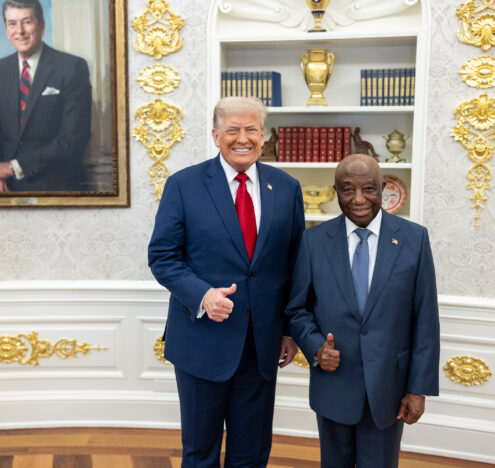In his speech before the UN General Assembly, President Joe Biden highlighted the importance of forging partnerships and building inclusive coalitions of countries to address some of the world’s most pressing challenges. Yet, the war in Ukraine has revealed the absence of such a global coalition condemning Russia, highlighting the disconnect between the United States and those countries not formally aligned with or against a major power.
In February 2023, the UN General Assembly adopted a resolution condemning Russian aggression in Ukraine, with 7 countries vetoing the measures and 32 countries abstaining altogether — including key countries such as India, Vietnam, and South Africa. As the United States grapples with an uncertain future with China, it must secure partnerships with non-aligned countries in Africa, Latin America, South and Southeast Asia, and the Middle East. Cooperating with these countries is a prerequisite for the United States to effectively compete with China. The United States must partner with non-aligned countries to diversify the US defense industrial base, prevent risks to US military operations in the region, and ensure collective action in the case of a Taiwan contingency.
China’s Supply Chain Advantage
For one, the United States must partner with non-aligned countries to diversify the US defense industrial base. The US House of Representatives’ Defense Critical Supply Chain Task Force concluded that “a significant amount of material in the Defense Industrial Base is sole-sourced from the People’s Republic of China.” The United States must rid itself of a dependency on China for critical mineral mining and processing and partner with non-aligned countries to diversify.
China’s stranglehold enables Beijing to weaponize access to critical minerals and rare earths. Most recently, China imposed export controls on gallium and germanium — critical inputs in solar panels and the semiconductor value chain. While not debilitating to the United States, these controls serve as a signal of how China could weaponize supply chains if economic competition between the United States and China heats up. In extreme circumstances, China could stop the export of rare earths and critical minerals needed for the US defense industrial base, thereby challenging the United States’ ability to produce military equipment — such as missile guidance systems, submarines, and aircraft — underpinned by rare earths and critical minerals. Ultimately, this would hobble the United States’ defense industrial base and could prevent the United States from surging capacity during a time of crisis. The United States must forge partnerships with countries in Africa, Latin America, and Southeast Asia to shore up its own national security vulnerabilities.
The US Geological Survey considers 50 minerals critical to US economic and national security, including “aluminum, cobalt, graphite, magnesium, manganese, titanium, tungsten and zinc.” Take cobalt, for instance, which is found in jet engines and gas turbines. The Democratic Republic of Congo (DRC) comprises 70% of the world’s cobalt, and Chinese entities have stakes in almost all of the country’s mines. Likewise, in 2022, Indonesia became the world’s second-largest cobalt producer, largely through joint ventures between Chinese companies and local groups.
As a first step, the United States must gain a better sense of the supply chain and countries that could fill the gap if the United States pivots away from Chinese rare earths and minerals. This analysis must map sources for critical minerals and rare earths as well as the countries processing these minerals — another strategic chokepoint for China. China processes most rare earth minerals, including 73% of cobalt for example. This supply chain mapping should underpin the United States’ approach to friend-shoring and forging partnerships with countries mining and processing these minerals — a number of which are in Latin America, Africa, and Southeast Asia. These countries, in turn, would benefit from US investment in the regions.
Offering an Alternative
Another reason to partner with non-aligned countries stems from the need to reduce risks to US military operations in the Indo-Pacific. The digital infrastructure of non-aligned countries threatens to inject risk into US military operations in the Indo-Pacific. China’s global digital infrastructure presents a two-fold risk to the United States in a potential Taiwan contingency. For one, Chinese company Huawei’s strong presence in Southeast Asia’s telecommunications networks would force US and allied militaries to operate on Huawei-enabled 5G networks, which poses significant risks to US data, intelligence, and potentially military operations. Recently, the United States gained access to military bases in the Philippines — a country relying on Huawei for its 5G rollout. This trend only threatens to accelerate as Huawei increases its presence in Southeast Asia as it faces obstacles in the West.
As the United States grapples with an uncertain future with China, it must secure partnerships with non-aligned countries in Africa, Latin America, South and Southeast Asia, and the Middle East. Cooperating with these countries is a prerequisite for the United States to effectively compete with China.
Additionally, China’s technological competitiveness is bolstered by Huawei’s growing market position across the globe. As Huawei’s market share wanes in the US and European markets, Huawei is intensifying its foothold in countries in Latin America, Africa, and Southeast Asia. For example, in Mexico and Brazil, Huawei partnered with the Mexican and Brazilian governments to handle government contracts, including for federal data centers. China, for its part, is shoring up Chinese companies’ market positions and securing government contracts for information communications technology and services in these markets. A strengthened market position of Chinese companies risks ceding technology leadership to China.
The United States has amplified its pressure on European countries to remove Huawei from its telecommunications networks, but the United States has not replicated this process in Africa, Latin America, and Southeast Asia — to its own detriment. The United States should highlight the risks of implementing Huawei 5G in these countries, such as the threat of espionage, erosion of data integrity, and China’s ability to cripple critical infrastructure underpinned by Chinese telecommunications. More importantly, the United States should provide an alternative to non-aligned countries. It should use funds from the Partnership for Global Infrastructure and Investment and the Development Finance Corporation to subsidize telecommunications operators in non-aligned countries to adopt safe and resilient telecommunications infrastructure from European providers, Nokia and Eriksson, and it should consider launching open RAN pilots in these countries. Open RAN is a new type of telecommunications network that uses specialized software to enable multiple hardware vendors to be used. It allows for the United States to provide a cost-effective 5G alternative — making it a promising solution for developing countries looking to implement cost-effective networks.
Building a Coalition
Finally, a failure to partner with non-aligned countries stymies collective action in response to aggression. The Ukraine crisis has illustrated the challenge of galvanizing a coalition of countries to impose costs on Russian aggression. While European Union countries and select allies in Southeast Asia have joined in US sanctions and export controls imposed on Russia, the rest of the world has not followed suit. Despite pressure from Western allies, the Association of Southeast Asian Nations (ASEAN) remains unwilling to condemn Russia’s war in Ukraine — a particularly troubling development if the United States expects the Asian bloc to renounce Chinese aggression in the case of a Taiwan invasion. Beijing continues to cement its influence in non-aligned countries, including through renewed talks with ASEAN to negotiate a new free trade agreement and through the BRICS, which invited six new members to join the bloc and considered the applications of dozens of additional members.
While sanctions remain a powerful tool in the US arsenal, the imposition of sanctions — and especially export controls — against China in the event of a Taiwan contingency would be more effective if done so in concert with a broad coalition of countries. Getting non-aligned countries to pick a side will be incredibly difficult, especially given that China’s retaliatory measures against countries who condemn China’s actions are well documented. To flip even a few fence sitters, the United States must take a comprehensive approach. The United States must strengthen the role of non-aligned countries in Western multilateral institutions and deliver on President Biden’s vision of a more inclusive UN outlined in his speech before the General Assembly.
Additionally, the West must continue to partner with non-aligned countries to provide an alternative to China’s Belt and Road Initiative investments. This includes through the EU’s Global Gateway, the G-7’s Partnership for Global Infrastructure Investment (PGII), and the newly announced India-Middle East Economic Corridor (IMEC). A reinvigorated role of Washington in non-aligned countries will potentially create a pressure release valve for countries who fear Beijing’s economic retaliation and who currently have no recourse or option to diversify the investments they receive.
Without a change in policy recognizing the shift to an increasingly multipolar world, the United States risks its own vital interests in non-aligned regions. Ignoring non-aligned countries will have national security ramifications for the United States in its competition with China. As US hegemony wanes and non-aligned countries are increasingly forging their own path, the United States must find a strategy that rests on being the best partner, not just the strongest one.




















